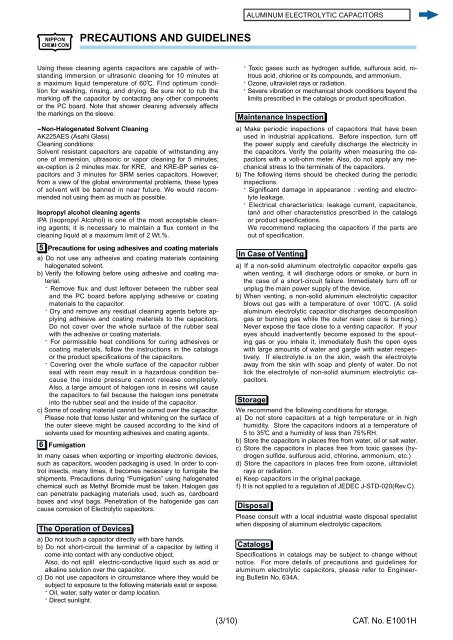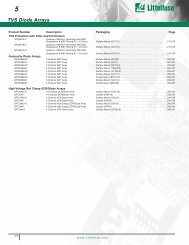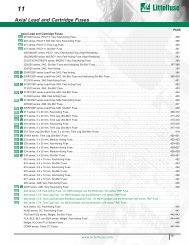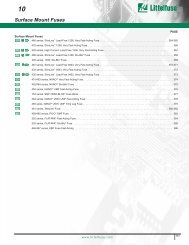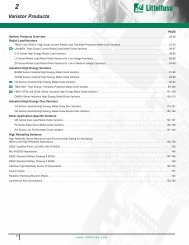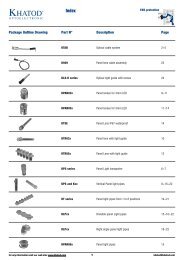ALUMINUM ELECTROLYTIC CAPACITORS
ALUMINUM ELECTROLYTIC CAPACITORS
ALUMINUM ELECTROLYTIC CAPACITORS
You also want an ePaper? Increase the reach of your titles
YUMPU automatically turns print PDFs into web optimized ePapers that Google loves.
PRECAUTIONS AND GUIDELINES<br />
Using these cleaning agents capacitors are capable of withstand<br />
ing immersion or ul tra son ic clean ing for 10 minutes at<br />
a maximum liquid temperature of 60C. Find optimum con di -<br />
tion for wash ing, rins ing, and drying. Be sure not to rub the<br />
mark ing off the capacitor by contacting any other com po nents<br />
or the PC board. Note that shower clean ing ad verse ly af fects<br />
the markings on the sleeve.<br />
-Non-Halogenated Solvent Cleaning<br />
AK225AES (Asahi Glass)<br />
Cleaning conditions:<br />
Solvent resistant capacitors are capable of with stand ing any<br />
one of immersion, ultrasonic or vapor cleaning for 5 min utes;<br />
ex -cep tion is 2 minutes max. for KRE, and KRE-BP series capac<br />
i tors and 3 minutes for SRM series capacitors. However,<br />
from a view of the global environmental problems, these types<br />
of solvent will be banned in near future. We would rec om -<br />
mend ed not us ing them as much as possible.<br />
Isopropyl alcohol cleaning agents<br />
IPA (Isopropyl Alcohol) is one of the most acceptable cleaning<br />
agents; it is necessary to maintain a fl ux content in the<br />
clean ing liquid at a maximum limit of 2 Wt.%.<br />
5<br />
a) Do not use any adhesive and coating materials containing<br />
ha lo ge nat ed solvent.<br />
b) Verify the following before using adhesive and coating ma -<br />
te ri al.<br />
· Remove fl ux and dust leftover between the rubber seal<br />
and the PC board before applying adhesive or coat ing<br />
ma te ri als to the capacitor.<br />
· Dry and remove any residual cleaning agents before apply<br />
ing adhesive and coating materials to the capacitors.<br />
Do not cov er over the whole surface of the rubber seal<br />
with the adhesive or coating ma te ri als.<br />
· For permissible heat conditions for curing adhesives or<br />
coat ing ma te ri als, follow the instructions in the catalogs<br />
or the product spec i fi ca tions of the capacitors.<br />
· Covering over the whole surface of the capacitor rubber<br />
seal with res in may result in a hazardous condition because<br />
the inside pres sure cannot release completely.<br />
Also, a large amount of halogen ions in resins will cause<br />
the ca pac i tors to fail because the halogen ions penetrate<br />
into the rub ber seal and the inside of the capacitor.<br />
c) Some of coating material cannot be curred over the ca pac i tor.<br />
Please note that loose luster and whitening on the surface of<br />
the outer sleeve might be caused according to the kind of<br />
solvents used for mounting adhesives and coating agents.<br />
6<br />
Precautions for using adhesives and coating ma te ri als<br />
Fumigation<br />
In many cases when exporting or importing electronic de vic es,<br />
such as capacitors, wooden packaging is used. In order to control<br />
insects, many times, it becomes necessary to fu mi gate the<br />
shipments. Precautions during “Fumigation” using halogenated<br />
chemical such as Methyl Bromide must be tak en. Halogen gas<br />
can penetrate packaging materials used, such as, cardboard<br />
boxes and vinyl bags. Penetration of the halogenide gas can<br />
cause corrosion of Electrolytic ca pac i tors.<br />
The Operation of Devices<br />
a) Do not touch a capacitor directly with bare hands.<br />
b) Do not short-circuit the terminal of a capacitor by letting it<br />
come into contact with any con duc tive object.<br />
Also, do not spill electric-conductive liquid such as acid or<br />
al ka line solution over the capacitor.<br />
c) Do not use capacitors in circumstance where they would be<br />
subject to exposure to the following ma te ri als exist or ex pose.<br />
· Oil, water, salty water or damp location.<br />
· Direct sunlight.<br />
(3/10)<br />
· Toxic gases such as hydrogen sulfi de, sulfurous acid, nitrous<br />
acid, chlorine or its compounds, and ammonium.<br />
· Ozone, ultraviolet rays or radiation.<br />
· Severe vibration or mechanical shock conditions beyond the<br />
lim its prescribed in the catalogs or product specifi cation.<br />
Maintenance Inspection<br />
a) Make periodic inspections of capacitors that have been<br />
used in industrial applications. Before inspection, turn off<br />
the power supply and carefully dis charge the elec tric i ty in<br />
the capacitors. Verify the polarity when mea sur ing the capac<br />
i tors with a volt-ohm meter. Also, do not apply any mechan<br />
i cal stress to the ter mi nals of the ca pac i tors.<br />
b) The following items should be checked during the periodic<br />
in spec tions.<br />
· Signifi cant damage in appearance : venting and elec tro -<br />
lyte leak age.<br />
· Electrical characteristics: leakage current, capacitance,<br />
tanE and oth er characteristics prescribed in the catalogs<br />
or prod uct spec i fi ca tions.<br />
We recommend replacing the capacitors if the parts are<br />
out of specifi cation.<br />
In Case of Venting<br />
a) If a non-solid aluminum electrolytic capacitor expells gas<br />
when venting, it will discharge odors or smoke, or burn in<br />
the case of a short-circuit failure. Immediately turn off or<br />
un plug the main pow er sup ply of the device.<br />
b) When venting, a non-solid aluminum electrolytic capacitor<br />
blows out gas with a temperature of over 100C. (A sol id<br />
alu mi num elec tro lyt ic ca pac i tor dis charg es de com po si tion<br />
gas or burn ing gas while the out er resin case is burning.)<br />
Never ex pose the face close to a venting ca pac i tor. If your<br />
eyes should inadvertently become exposed to the spout -<br />
ing gas or you in hale it, im me di ate ly fl ush the open eyes<br />
with large amounts of wa ter and gargle with water re spec -<br />
tive ly. If elec tro lyte is on the skin, wash the elec tro lyte<br />
away from the skin with soap and plenty of water. Do not<br />
lick the elec tro lyte of non-solid aluminum elec tro lyt ic capac<br />
i tors.<br />
Storage<br />
We recommend the following conditions for storage.<br />
a) Do not store capacitors at a high temperature or in high<br />
hu mid i ty. Store the capacitors indoors at a temperature of<br />
5 to 35C and a hu mid i ty of less than 75%RH.<br />
b) Store the capacitors in places free from water, oil or salt wa ter.<br />
c) Store the capacitors in places free from toxic gasses (hydro<br />
gen sul fi de, sulfurous acid, chlorine, ammonium, etc.)<br />
d) Store the capacitors in places free from ozone, ultraviolet<br />
rays or ra di a tion.<br />
e) Keep capacitors in the original package.<br />
f) It is not applied to a regulation of JEDEC J-STD-020(Rev.C).<br />
Disposal<br />
Please consult with a local industrial waste disposal specialist<br />
when disposing of aluminum electrolytic ca pac i tors.<br />
Catalogs<br />
Specifi cations in catalogs may be subject to change without<br />
no tice. For more details of precautions and guidelines for<br />
alu mi num electrolytic capacitors, please refer to En gi neering<br />
Bulletin No. 634A.<br />
CAT. No. E1001H


